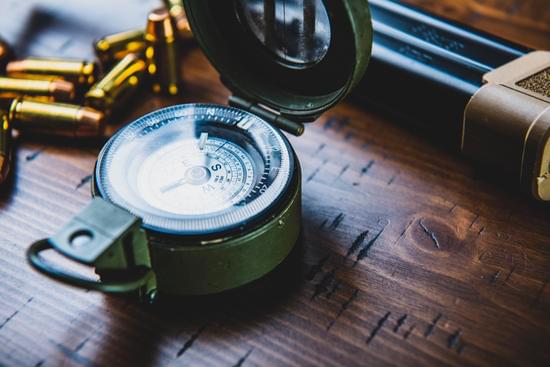How Do You Read a Compass?
Are you planning on going on an outdoor adventure? If so, you'll need to know how to use a compass. A compass is a navigation tool that uses the Earth's magnetic field to show you which direction is north.
In this article, we'll discuss the factors that can affect the accuracy of your compass reading, as well as the key components of a compass and how to use it. We'll also talk about online compasses, which are a great option for people who want to simplify their navigation game.
Let's get started!

Factors that can affect the accuracy of your compass reading:
- Magnetic objects:Compasses are sensitive to magnetic fields, so it's important to keep them away from metal objects, such as zippers, cameras, phones, and watches. Even small magnets can interfere with the compass needle, so it's best to keep it away from anything with a magnetic field.
- Unusual magnetic fields:Some objects, like wired bras, can create their own magnetic fields that can interfere with the compass needle. If you're not sure whether an object will interfere with your compass, it's best to err on the side of caution and keep it away.
- Rock types:Certain types of rocks, especially those rich in iron, can also affect the compass needle. These rocks were formed during periods when magnetic north was different from its current position, so they can create a localized magnetic field that can throw off your compass reading.
If you're worried about the accuracy of your compass reading, it's always a good idea to double-check it with a map or GPS. And if you're in an area with a lot of magnetic interference, you may want to consider using a compass that is designed to be more resistant to interference.
What Exactly Is a Bearing?
In the world of compass navigation, a bearing is like your compass's way of whispering directions to you. It's essentially the angle between where the north (N) is, where you are right now, and where you want to go. Think of it as your compass telling you, "Hey, go this way to reach your destination!"
But here's a friendly tip to avoid a common hiccup: when you twist that compass housing, make sure the arrow on the housing lines up perfectly with the north direction on your map. If it's a bit wonky and doesn't align correctly, your bearing might go haywire, sending you in the opposite direction. Sure, technically, if you add 180 degrees to that mess, you'll get the right bearing, but let's not complicate things. It's a recipe for confusion.

Even tiny errors, like being a few degrees off, can throw a wrench into your navigation game. This can happen if you don't line up your compass edge with each map reference point or if that housing arrow gets a bit crooked in relation to the map's grid lines. So, remember, precise alignment and a good dose of attention to detail are your trusty sidekicks for nailing those compass bearings and making sure you're on the right path during your adventure.
The Key Components of a Compass
- Magnifying Glass:While not a must-have, a magnifying glass is like the cherry on top of your compass. It's there to help you zoom in on the fine details of your map, making everything crystal clear. Think of it as your trusty sidekick for deciphering intricate paths through tricky terrain.
- Compass Housing:The compass housing is the heart and soul of your compass. It's the sturdy home for your compass needle. Without it, you can't really call it a compass.
- Compass Needle:This is the superstar of your compass. It's usually red at the north end and a different color at the opposite end. Some fancy modern ones are made of plastic but still have magnetic oomph thanks to tiny bar magnets. The needle's job? Always pointing north and showing you the way.
- Damping Liquid:Inside the compass housing, there's a special liquid (usually white spirit). Its mission is to keep your compass needle from going bonkers. It prevents wild swings and keeps your readings on point. In other words, it's your compass's chill pill.
- Needle Material and Pivot Point:The materials of your needle and the quality of its pivot point are compass stability MVPs. High-end compasses like Silva's use industrial sapphire for needles and rock-solid pivot points. It's all about keeping that needle smooth and accurate.
- Orienting Lines:These lines, often marked by a snazzy arrow or glow-in-the-dark paint, are your compass's way of saying, "Align me with the map grid lines!" They point north and help you take the right bearings.
- Cardinal Points and Subdivisions:Surrounding the compass housing, you'll find the cardinal points (N, S, E, W) and some nifty smaller divisions. They're like your compass's measuring tape, ensuring precision in your navigation. Check out the degree scale around the housing for extra accuracy.
- Base Plate:The base plate is like the comfy grip of your compass. It's clear, it's plastic, and it's designed to fit snugly in your hand. Sizes vary to match your grip preference.
- Attachment Provisions:Your compass base plate often has handy spots for attaching a string or lanyard. This feature is all about convenience, making sure your compass is right where you need it during your adventures.
How to Use Your Compass: A Step-by-Step Adventure
Reading a compass might seem like a daunting task, but fear not—it's simpler than you think! Here's your friendly guide:
- Map Orientation:Start by placing your trusty compass on the map. Position it between where you are (your current spot) and where you want to go (your intended destination). Make sure the arrow on your compass, showing the direction of travel, points where you plan to journey.
- Housing Alignment:Give your compass housing a little spin so that the housing arrow snuggles up to the north. At the same time, ensure the orienting lines on your compass are buddies with the vertical grid lines on the map.
- Finding Your Bearing:Check out the degree scale on your compass, all while keeping an eye on the direction of travel arrow. For pinpoint accuracy, add (or subtract, if the magnetic variation leans east of grid north) the magnetic variation listed on your map's key.
- Body Harmony:Now, let's get cozy with your compass. Hold it close to your body and make sure the red end of the compass needle becomes best friends with the housing arrow. This little dance ensures you're facing the right way.
- Spot the Landmark:Follow the path marked by your compass's travel arrow and spot something special along the way. It could be a rock, a friendly tree, a distant landmark, or anything distinctive you can stride toward.
- Stow the Compass:Once you've got your landmark locked in, it's time to tuck away your compass. There's no need to clutch it constantly—trust that it's got you covered. Enjoy your walk and keep an eye on that special spot you've chosen.
- The Optional Back Bearing Check:If you haven't lost sight of where you started, you can do a little backtrack dance. Point your compass in the opposite direction this time, aligning the housing arrow with the other end of the compass needle (not the red one). If your travel arrow nods back to your starting point, you're still on the right track. If not, a few adjustments will get you back on course.

Discovering the Online Compass: Your Guide to Online Tools
When it comes to finding your way in the digital age, live compass tools have got your back. Forget about magnetic quirks and complexities—live compasses are here to simplify your navigation game.

The Advantages of Going Online
- Reading an online compass is a walk in the park compared to its magnetic cousin. It's as easy as pie!
- They'll happily point you in the right direction: north, south, east, and west.
- Get started by installing specific apps on your mobile or visiting dedicated websites. Apps like Google Maps are multitaskers, merging compass and GPS functions for a full-service experience.
- But if you're here for the compass thrill, standalone apps and websites such as our website have got you covered.
Pro Tips for Online Compass Pros
- Calibrate for Precision:Make sure your device is calibrated. It's like fine-tuning an instrument, and it ensures spot-on readings.
- Hold It Right:Hold your phone the way your compass app likes it. Whether it's vertical or horizontal, your phone's orientation matters for accurate results.